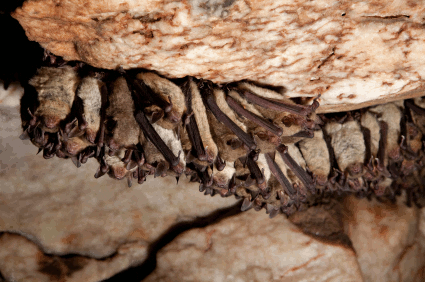|
Hibernaculum - A Bat's Winter HomeBats in temperate climate zones spend the colder months in a hibernaculum (hibernation site). This can be a cave (like the one in the photo) or disused mine, a hollow in a tree or a stone wall. Sometimes, bats will also hibernate in the cavity walls of houses.
Conditions need to be just right with temperatures ranging between 0° and 15°C. Warm temperatures speed up chemical reactions in the body, which use up energy. Bats hibernate so that they can save energy so this is why their winter homes need to be cold. These furry animals lower their body temperatures to match their surroundings. Their heart rates slow right down as does their breathing and this state is known as torpor. As the weather gets colder and colder, they stay torpid for longer periods of time. Hibernating bats also need to be in a humid environment so that they dehydrate. And since bats are at their most vulnerable when they hibernate, winter roosts must be somewhere predators can't get to easily. During the summer and autumn, bats in temperate zones will have built up stores of energy (known as brown fat). This is usually enough to see them through the cold months. But if they're disturbed and wake up too many times, it may mean that they won't make it through to the following spring. Human activities often lead to the destruction of hibernacula and are partly to blame for the decrease in numbers some bat species are facing. However, efforts are being taken to remedy this. Take a look at this human-made hibernation site. Return from Hibernaculum to Chiroptera - the oder of bats
|







